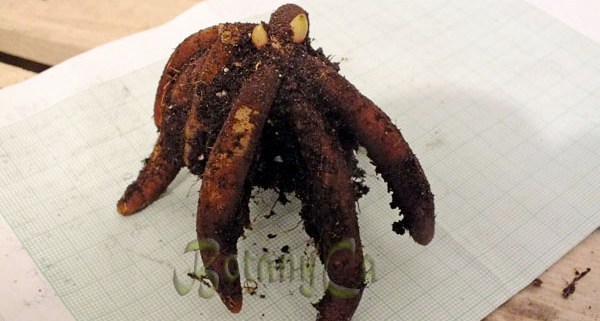First, in the idea that a picture is worth a thousand words: Trillium grandiflorum leftover seeds from 2021, germinating after following a warm (summer-fall 2021)- cold (winter 2021-2022) – warm (spring-summer 2022) cycles regime.
They took me by surprise, usually the rootlets start to grow somewhere in September.

Trillium grandiflorum germinated seeds from 2021 harvest; they need one more cold cycle (winter 2022) for the leaves to appear
As I mentioned before, from any batch of Trillium grandiflorum seeds, part of them always germinate (root) in the first fall and the remaining seeds will germinate in the second fall. So, those who purchased T. grandiflorum seeds last year may have in their pots a combination of seedlings with the first leaves plus only germinated seeds (root only, like in the picture). It is also possible to have only germinated seeds (like seen in the picture).
Other Trillium species follow the same pattern (complete germination in 2 years), others germinate entirely in the first season, and others only germinate in the second year (e.g., Trillium erectum usually only germinates in the second year after sowing).
Latest seeds collected:
Caulophyllum thalictroides and Actaea pachypoda fo. rubrocarpa (wild)
Edraianthus graminifolius, Roscoea schneideriana and Roscoea tibetica (garden)
Clematis occidentalis and Clematis alpina (on-going) – these are early spring flowering species.
The Seeds Shop will be open for orders starting August 29th. There will be another announcement with few a important details on Sunday (Aug. 28th) before the re-opening.
The Seeds List has been updated as much as possible. Plus, there is a tab with various announcements at the top. It is always a work in progress: some species get sold out fast and for others the seeds are ready only later in the fall.
The first species that require attention/sowing right away are the following:
ALL Moist Packed seeds, Paeonia, Helleborus, Lilium species, Actaea, Aralia, Hydrophyllum.
Besides using the Seed List, on the main page click on the SEEDS SHOP tab on top-right for a direct access to various categories.
There is hope for more seeds collecting to be done this week. Until next…















